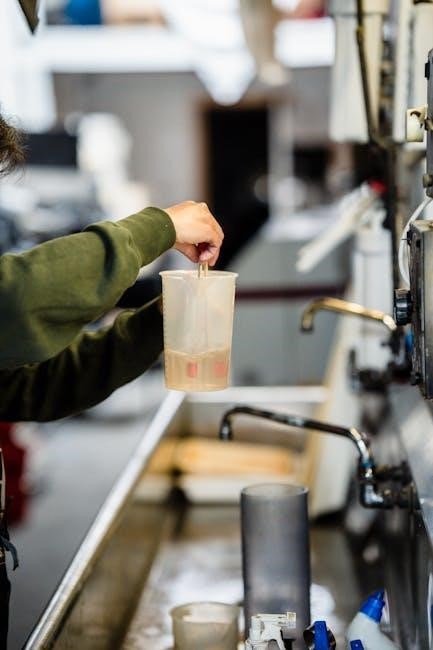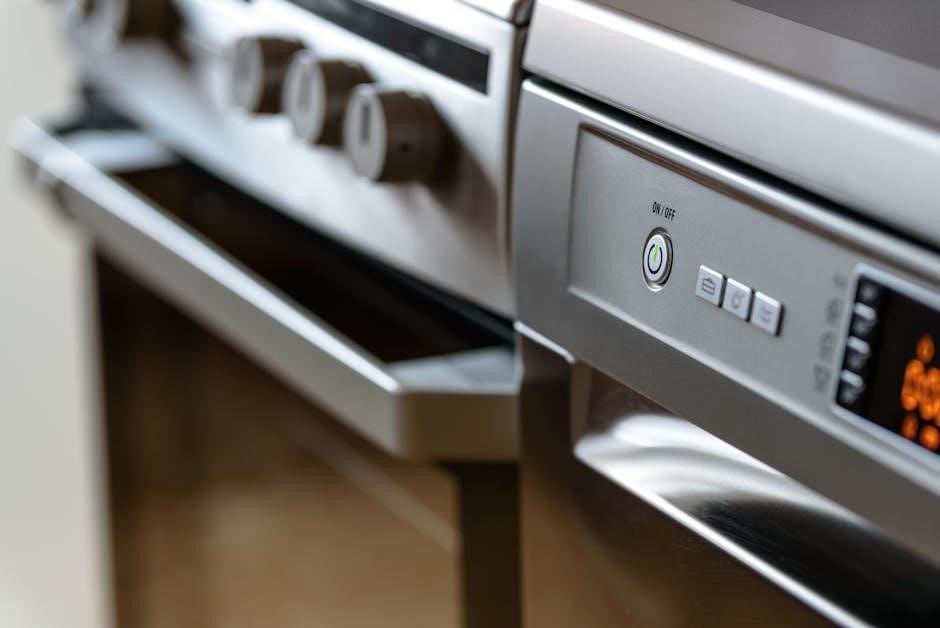The GE stove self-cleaning feature simplifies oven maintenance by using high temperatures to burn away food residue, leaving a light ash that’s easy to wipe away. This convenient option reduces manual scrubbing, making oven cleaning faster and more efficient for homeowners.
1.1 What is Self-Cleaning Technology?
Self-cleaning technology in GE stoves is an innovative feature designed to simplify oven maintenance. It uses high temperatures, typically exceeding 800°F, to burn food residue and spills into a light ash, which can be easily wiped away after the cycle completes. This process eliminates the need for harsh chemicals or extensive scrubbing, making oven cleaning faster and more efficient. The technology is integrated into specific GE stove models, providing homeowners with a convenient solution for maintaining their appliances. By leveraging heat to break down grime, self-cleaning ovens offer a modern, time-saving alternative to traditional cleaning methods.
1.2 Benefits of Using the Self-Cleaning Feature
Using the self-cleaning feature on your GE stove offers numerous benefits, making it a valuable tool for maintaining your appliance. The high-temperature cycle effectively removes tough food residue without the need for abrasive cleaners, preserving the oven’s finish. This feature saves time, as it eliminates the need for manual scrubbing, and reduces the effort required to keep your oven clean. Additionally, it helps maintain hygiene by thoroughly sanitizing the interior. The self-cleaning process is also environmentally friendly, as it minimizes the use of chemical-based cleaning products. Overall, this feature enhances the longevity and performance of your GE stove while providing a convenient cleaning solution.
1.3 GE Stove Models with Self-Cleaning Option
Several GE stove models are equipped with the self-cleaning feature, offering convenience and efficiency. Popular models include the JBP25, JBP45, JBP46, JBP47, and PGB935, among others. These ranges, both electric and gas, are designed with advanced self-cleaning technology to simplify oven maintenance. The self-cleaning option is particularly beneficial for busy households, as it eliminates the need for harsh chemicals or extensive manual labor. By utilizing high temperatures to burn away food residue, these models provide a hassle-free cleaning experience. Always refer to your specific model’s manual to confirm the self-cleaning feature and its operational guidelines, ensuring optimal performance and safety.

Preparing Your GE Stove for Self-Cleaning
Preparing your GE stove for self-cleaning involves removing racks and accessories, ensuring the oven is empty, and protecting nearby surfaces from heat and residue. This step is crucial for safe and effective cleaning.
2.1 Removing Racks and Accessories
Before initiating the self-cleaning cycle, it is essential to remove all racks, baking sheets, and accessories from the oven. This prevents warping or discoloration of these items due to the extreme heat generated during the cleaning process. Additionally, leaving racks inside can hinder the effectiveness of the self-cleaning feature. For models with catalytic self-cleaning panels, racks may remain, but they will darken and become harder to clean over time. Always refer to your specific GE stove manual to confirm if racks can stay in during cleaning. Removing accessories ensures a safer and more efficient self-cleaning cycle.
2.2 Protecting Surrounding Surfaces
When preparing your GE stove for self-cleaning, it is crucial to protect surrounding surfaces from potential damage. Cover countertops, floors, and nearby appliances with drop cloths or newspapers to catch any debris or ash that may escape. Use a damp cloth to wipe down the exterior of the oven and stove to prevent streaks from forming during the cycle. Additionally, ensure the area around the stove is well-ventilated to minimize the impact of fumes. Avoid using abrasive cleaners on surrounding surfaces, as they may damage finishes. For tougher stains, a soft cloth and mild detergent can be used to clean without scratching. Proper protection ensures a safe and mess-free self-cleaning experience.
2.3 Cleaning Before Initiating Self-Cleaning Cycle
Cleaning your GE stove before starting the self-cleaning cycle is essential for optimal results. Remove large food particles and spills to prevent excessive smoke during the cycle. Wipe down the oven walls, floor, and racks with a damp cloth and mild detergent to eliminate loose debris. Avoid using abrasive cleaners, as they may damage the finish. For tough stains, a soft sponge or cloth can be used gently. Ensure all racks and accessories are removed, as they may darken during the cycle. Proper pre-cleaning ensures the self-cleaning process works efficiently and minimizes the risk of harmful fumes. This step also helps maintain the oven’s appearance and functionality over time.

The Self-Cleaning Process
The GE stove self-cleaning process uses high temperatures to burn food residue into ash, simplifying post-cleaning efforts. The cycle runs for several hours, requiring no intervention.
3.1 How to Start the Self-Cleaning Cycle
To initiate the self-cleaning cycle on your GE stove, ensure the oven is empty of racks and accessories. Press and hold the Self Clean button until the display shows the cleaning option. Use the temperature or control knobs to select the desired cleaning time, typically 2-4 hours, depending on soil level. Close the oven door firmly until it locks automatically. The stove will begin heating to a high temperature, burning food residue into ash. Ensure proper ventilation, as fumes may release during the cycle. Avoid opening the door until the cycle completes and the stove cools slightly. Always follow the manual for model-specific instructions.
3.2 Understanding the Cleaning Duration
The self-cleaning cycle on a GE stove typically lasts between 2 to 4 hours, depending on the level of soil and the selected cleaning mode. Light cleaning may take 2 hours, while heavy-duty cleaning can require up to 4 hours or more. The stove heats to extremely high temperatures during this process, effectively burning food residue into ash. It’s important to let the cycle complete and allow the oven to cool slightly before wiping away the ash. Some models may have preset cleaning times, while others allow manual adjustment. Always refer to your specific model’s manual for exact duration guidelines and ensure proper ventilation during the cycle to avoid fumes buildup.
3.3 What Happens During the Cycle
During the self-cleaning cycle, your GE stove heats to extreme temperatures, typically between 800°F and 900°F, to incinerate food residue into ash. The oven door locks automatically to ensure safety and maintain heat. This intense heat breaks down tough grime and food particles, making them easier to clean. The process is noisy due to the high heat, and you may notice fumes or odors, which is normal. After the cycle ends, the oven will be hot for some time. Once cooled slightly, you can wipe away the ash with a damp cloth. This efficient method eliminates the need for harsh chemicals, providing a cleaner and safer way to maintain your oven.

Safety Precautions
Ensure proper ventilation to avoid inhaling fumes. Keep children and pets away during the self-cleaning cycle. Never touch hot surfaces, and always wear oven mitts when handling.
4.1 Ventilation Requirements
Proper ventilation is crucial during the self-cleaning cycle to prevent the buildup of harmful fumes. Open windows and use an exhaust fan to ensure good airflow. The fiberglass insulation in self-cleaning ovens releases small amounts of carbon monoxide during the cycle, so venting is essential to minimize exposure. Keeping the kitchen well-ventilated helps maintain a safe environment and reduces odors. Additionally, ensure your oven is installed with a venting system that meets manufacturer guidelines. Failure to ventilate properly can lead to unpleasant fumes lingering in the home. Always prioritize ventilation to ensure a safe and effective cleaning process.
4.2 Avoiding Exposure to Fumes
Avoiding exposure to fumes during the self-cleaning cycle is crucial for health and safety. The high temperatures used in the process release fumes, including carbon monoxide from the oven’s insulation, which can be hazardous if inhaled. To minimize exposure, ensure proper ventilation by opening windows and using an exhaust fan. Avoid staying in the kitchen during the cleaning cycle, especially if you have respiratory issues. Keep the kitchen well-ventilated to prevent fumes from lingering. Never cover vent slots, as this can trap harmful gases. If you notice strong fumes, turn off the oven and ventilate the area immediately. Always prioritize your health by avoiding direct exposure to these fumes during the self-cleaning process.
4.3 Keeping Children Away During Cleaning
Keeping children away during the self-cleaning cycle is essential for their safety. The high temperatures and toxic fumes released during the process pose serious risks to children. Ensure the kitchen is supervised, and kids are kept at a safe distance. The oven door locks during cleaning, but children may still attempt to open it, leading to burns or exposure to harmful fumes. Use child safety locks on the oven to prevent accidental opening. Educate children about the dangers of the self-cleaning cycle and keep them occupied in another room. This ensures their safety and allows the cleaning process to complete without interruptions.

Maintenance and Care After Self-Cleaning
After the self-cleaning cycle, allow the oven to cool before wiping it down with a damp cloth to remove ash. Avoid harsh chemicals to maintain the finish and ensure longevity. Regular checks for residue and proper ventilation will keep your GE stove functioning optimally and safely.
5.1 Wiping Down the Oven After Cleaning
After the self-cleaning cycle, allow the oven to cool completely before wiping it down. Use a soft, damp cloth to remove the ash and residue, ensuring no harsh chemicals are used. For tougher spots, a mild detergent can be applied, but avoid abrasive cleaners or scrubbers to prevent damage to the finish. Rinse the cloth thoroughly and wipe away any soap residue. This step ensures the oven remains clean and free of harmful fumes. Regular wiping also prevents residue buildup, maintaining the oven’s efficiency and appearance. Proper ventilation during and after cleaning is crucial to remove any lingering fumes. Always follow the manual’s guidelines for safe and effective maintenance.
5.2 Cleaning the Oven Door and Windows
Cleaning the oven door and windows is essential for maintaining visibility and hygiene. After the self-cleaning cycle, use a soft cloth and mild detergent to wipe down the door and glass surfaces. Avoid abrasive cleaners or scrubbers, as they may scratch the glass. For stubborn residue, mix baking soda and water to create a paste, apply it to the glass, and let it sit before wiping clean. Remove any racks or accessories to clean the door thoroughly. Ensure the door is cool to avoid burns. Regular cleaning prevents grime buildup and ensures optimal visibility during cooking; Always refer to the GE manual for specific recommendations on approved cleaning products and techniques to maintain your oven’s appearance and functionality.
5.3 Routine Maintenance Tips
Regular maintenance ensures your GE stove remains efficient and clean. After each use, wipe down surfaces with a soft cloth and mild detergent to prevent grime buildup. Check for food residue before initiating the self-cleaning cycle, as large amounts can create excessive smoke. Avoid using abrasive cleaners or scrubbers, which may damage the finish. For tough stains, apply a gentle cleaning solution and let it sit before wiping. Periodically inspect and clean the oven vents to ensure proper airflow. Consider using steam cleaning for lighter messes to avoid frequent self-cleaning cycles. Always refer to the GE manual for recommended cleaning products and schedules to maintain your stove’s performance and longevity.

Troubleshooting Common Issues
Common issues include malfunctioning self-cleaning features, error codes, or fumes; Check door alignment, ensure racks are removed, and consult the manual for error code solutions. If unresolved, contact a technician.
6.1 Malfunctioning Self-Cleaning Feature
If the self-cleaning feature on your GE stove malfunctions, it may fail to start or complete the cycle. Common causes include incorrect door alignment, blocked vents, or error codes. Check if racks or accessories are improperly placed, as this can obstruct the cycle. Ensure the oven door is closed and locked firmly. If an error code appears, refer to the user manual for specific solutions. In some cases, turning off the oven, waiting, and restarting the cycle can resolve the issue. If problems persist, disconnect power and contact a certified technician to avoid further complications or safety risks.
6.2 Error Codes and Solutions
GE stoves may display error codes during the self-cleaning cycle, indicating specific issues. Common codes include E1 or E2, often related to temperature sensor malfunctions. If an error occurs, switch off the oven, wait a few minutes, and restart the cycle. For persistent issues, consult the user manual or contact GE support. Some codes may require professional assistance to resolve underlying hardware problems. Always ensure proper ventilation and follow safety guidelines when addressing errors to prevent further complications. If unsure, disconnect power and seek expert help to avoid potential hazards or damage to the appliance. Regular maintenance can help minimize error occurrences during self-cleaning cycles.
6.3 When to Call a Technician
If the self-cleaning feature fails to start or complete, or if error codes persist after restarting, it’s essential to contact a certified technician. Issues like the oven not heating, unusual noises, or the door not locking during the cycle also require professional attention. Additionally, if the self-cleaning process causes damage or leaves harmful residues, seek expert assistance. Always disconnect power before allowing a technician to inspect or repair the appliance. Attempting DIY repairs can lead to safety hazards or further damage. A qualified technician will ensure proper functionality and safety, addressing complex issues beyond basic troubleshooting. Regular maintenance by a professional can also prevent future problems and extend the appliance’s lifespan.

Environmental and Health Considerations
GE stove self-cleaning emits minimal carbon monoxide from insulation. Ensure proper ventilation to minimize exposure. Dispose of cleaning residue safely to protect the environment and maintain health safety.
7.1 Emissions During Self-Cleaning
During the self-cleaning cycle, GE stoves emit minimal carbon monoxide from the fiberglass insulation. These emissions are typically low but can increase in poorly ventilated areas. Proper ventilation is crucial to minimize exposure. Users are advised to open windows or use a ventilation fan to reduce indoor concentrations. The emissions are a natural byproduct of the high-temperature cleaning process, which breaks down food residue. While the levels are generally safe, prolonged exposure should be avoided. Following the manufacturer’s guidelines ensures safe operation and minimizes potential health risks associated with these emissions.
7.2 Safe Disposal of Cleaning Residue
The residue left after the self-cleaning cycle is a fine ash that is non-toxic but should still be disposed of carefully. Allow the oven to cool completely before wiping down surfaces with a damp cloth to collect the ash. Avoid inhaling the dust when handling the residue. Dispose of the collected ash in your regular household trash, as it is not classified as hazardous waste. However, check local regulations for specific guidelines, as some areas may have restrictions. Never pour ash down drains, as it could cause clogs. Proper disposal ensures a safe and environmentally responsible cleaning process.
7.3 Eco-Friendly Alternatives
For those seeking eco-friendly alternatives to the self-cleaning feature, consider using mild detergents or natural cleaning agents like vinegar and baking soda. These methods are gentler on the environment and avoid the high energy consumption of the self-cleaning cycle. Steam cleaning is another option, using water vapor to loosen grime without harsh chemicals. Additionally, regular light cleaning after meals can prevent heavy buildup, reducing the need for intense cleaning cycles. These alternatives align with sustainable practices and minimize environmental impact while maintaining oven cleanliness. By choosing eco-friendly methods, users can contribute to a greener household and reduce reliance on energy-intensive features.

Cost and Energy Efficiency
The GE stove’s self-cleaning feature balances energy consumption with efficiency, using high heat to burn residue. While the cycle consumes significant power, it reduces long-term cleaning costs.
8.1 Energy Consumption During Self-Cleaning
During the self-cleaning cycle, GE stoves operate at high temperatures, typically between 800°F and 900°F, which significantly increases energy consumption. This process requires substantial power to maintain such intense heat levels. The duration of the cycle, usually ranging from 2 to 4 hours, also contributes to higher energy usage. Users should note that while this feature is efficient for cleaning, it does consume more energy than regular oven operations. Proper ventilation is recommended to minimize exposure to fumes and ensure safety. However, the convenience and effectiveness of the self-cleaning feature make it a worthwhile investment for many homeowners. Always refer to the user manual for specific energy usage details.
8.2 Long-Term Cost Savings
The GE stove self-cleaning feature offers long-term cost savings by reducing the need for harsh chemical cleaners and minimizing labor-intensive manual cleaning. Over time, this eliminates the expense of frequently purchasing cleaning products. Additionally, the high-temperature cleaning process helps maintain the oven’s efficiency, potentially lowering energy bills by ensuring optimal performance. The feature also extends the lifespan of the stove by preventing food residue buildup, which can damage surfaces over time. While the initial energy consumption during cleaning is higher, the overall savings from reduced maintenance and extended appliance life make it a cost-effective solution for homeowners. Regular use of this feature ensures your stove remains in excellent condition, avoiding costly repairs or premature replacement.
8.3 Comparison with Manual Cleaning
The GE stove self-cleaning feature offers a significant advantage over manual cleaning by eliminating the need for scrubbing and harsh chemicals. While manual cleaning requires time and effort to remove grime, the self-cleaning cycle uses high temperatures to burn food residue into ash, which is easy to wipe away. This method is faster and less labor-intensive, saving time and energy. Additionally, it reduces the risk of exposure to strong fumes from cleaning products. However, the self-cleaning process requires a longer duration and higher energy use. Overall, it provides a more convenient and efficient alternative to traditional manual cleaning methods, making it a preferred choice for many homeowners.

User Reviews and Experiences
Users praise the GE stove self-cleaning feature for its efficiency and convenience, though some note the long cleaning cycle and potential for residual odors after use.
9;1 Customer Feedback on Self-Cleaning Feature
Customers generally praise the GE stove self-cleaning feature for its effectiveness in removing tough food residue with minimal effort. Many appreciate how it reduces the need for manual scrubbing, saving time and effort. However, some users note that the high temperatures during the cycle can produce strong odors and fumes, emphasizing the importance of proper ventilation. A few users mention that the feature works best when the oven is not excessively soiled, as heavy buildup may require multiple cycles. Overall, the self-cleaning feature is seen as a convenient and efficient option for maintaining oven cleanliness, though it may require some planning and precautions to use effectively.
9.2 Common Praise and Complaints
Many users praise the GE stove self-cleaning feature for its efficiency in removing food residue without manual scrubbing. The high temperatures effectively burn away grime, leaving the oven looking like new. However, some users complain about the long cleaning cycle duration, which can take several hours. Others mention that the intense heat can damage oven racks or accessories if left inside. Additionally, there are reports of lingering fumes and odors, which require proper ventilation. A few users also note occasional malfunctions of the self-cleaning feature, requiring professional assistance. Despite these issues, the feature remains popular for its convenience and effectiveness in maintaining oven cleanliness.
9.3 Tips from Experienced Users
Experienced users recommend following the manual closely for optimal results. Always remove racks and accessories before starting the cycle to prevent damage. Light cleaning before initiating the self-clean cycle helps reduce intense fumes. Use a mild detergent and soft cloth for post-cycle wiping to avoid scratches. Ensure proper ventilation to minimize odor exposure. Avoid abrasive cleaners, as they can harm the oven’s finish. Regular maintenance, like wiping spills immediately, extends the oven’s longevity. Some users suggest shorter cleaning cycles for lighter messes to save energy and time. Overall, these tips enhance the efficiency and safety of using the GE stove’s self-cleaning feature while maintaining your appliance’s condition.
The GE stove self-cleaning feature offers a convenient, efficient way to maintain your oven. Always follow the manual for optimal results and safety. Regular use ensures long-term performance.

10.1 Summary of Benefits
The GE stove self-cleaning feature offers numerous benefits, including reduced manual effort, efficient food residue removal, and a cleaner oven with minimal upkeep. High temperatures effectively burn away tough grime, leaving behind a light ash that’s easy to wipe off. This feature saves time and effort compared to traditional cleaning methods. It also ensures a safer cleaning process by minimizing direct contact with harsh chemicals. Additionally, the self-cleaning function enhances oven longevity by maintaining its interior condition. Proper ventilation is recommended to manage fumes, but overall, this feature provides a convenient and effective solution for maintaining your oven’s hygiene and performance. Regular use ensures optimal results and prolongs the appliance’s lifespan.
10.2 Importance of Following Manual Instructions
Adhering to the GE stove manual instructions is crucial for safe and effective use of the self-cleaning feature. Proper preparation, such as removing racks and protecting surfaces, prevents damage and ensures optimal cleaning. Incorrect settings or ignoring ventilation guidelines can lead to fume exposure or incomplete cleaning. The manual provides specific guidance tailored to your stove model, maximizing efficiency and safety. Deviating from instructions risks damaging the appliance or causing malfunctions. Always refer to the manual for model-specific advice, as procedures may vary. Following these guidelines ensures a smooth cleaning process, maintains your stove’s longevity, and guarantees a safe cooking environment for years to come.
10.3 Final Tips for Optimal Use
For optimal use of the GE stove self-cleaning feature, always clean up large spills before initiating the cycle to ensure better results. Regularly wiping down surfaces after cooking can reduce the need for frequent deep cleans. Use the self-cleaning option sparingly, as excessive use may wear down the oven’s interior. After the cycle, allow the oven to cool before wiping away ash with a damp cloth. Avoid using abrasive cleaners, as they can damage the finish. Check for error codes in the manual if issues arise and perform routine maintenance on hinges and seals to maintain efficiency. Proper care ensures your GE stove remains reliable and performs at its best for years.
